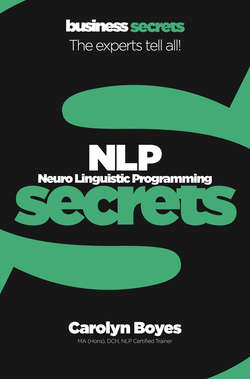Читать книгу NLP - Carolyn Boyes - Страница 9
1.4 Recognize your preferred sense
ОглавлениеEach day we experience the world through the five senses. These are known as the Visual, or seeing, sense; the Auditory, or hearing, sense; the Kinesthetic, or touch and feeling, sense; the Olfactory, or smell, sense; and the Gustatory, or taste, sense. People rely on these five senses to different degrees.
We store representations of the outside world inside our subconscious using our senses. This is how a memory can bring back a smell, picture or sound. In NLP the senses are called representational systems.
We each subconsciously use one sense more than the others. Some store memories primarily as images. Others delete more of what they see, and store more sound images. If you subconsciously prefer the visual sense you may be drawn towards visual work. If you’re more sound focused, then you may be especially fascinated by music or language. Or perhaps you prefer touch and feeling, and so favour physical pursuits, such as sport or working with your hands.
Just because you have a preference for one sense over another doesn’t mean that you can’t use all of them. This affects learning differences. If you prefer the visual, you may want visual props when
one minute wonder Be careful how you present information to others in business. Listen to the language the other person is using and use similar language back to them. If you are not sure about someone’s preferred systems, make sure you present in a range of ways to cover different groups. Don’t use only your preferred style.
learning. Auditory learners need to hear information to take it in efficiently. Kinesthetic learners like to try out what they are learning, for example through exercises and role play.
People give away their preferred sense through the words they choose. Use their preferred words and they will relate to you better. For example:
• Visual words. Look, see, clear, bright, sparkling, picture, clarify, perspective, illustrate, focus, colourful, watch, illusion, shine, dim, vivid.
• Auditory words. Noise, hear, resonate, deaf, speak, rhythm, ask, silent, tune, pitch, buzz, audible, earful, remark, tongue-tied, rings a bell.
• Kinesthetic words. Feel, unfeeling, solid, concrete, hit, pressure, hothead, handle, soft, hard, cold, tickle, seize, pressure, get in touch with.
By finding out which senses you and your colleagues individually prefer, you can learn about your different maps of the world, different learning styles and how to communicate more flexibly.
People vary in the way they perceive the world through the different senses.
